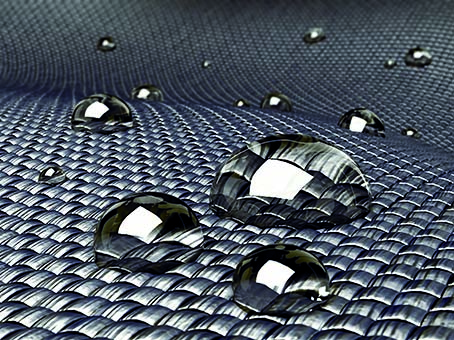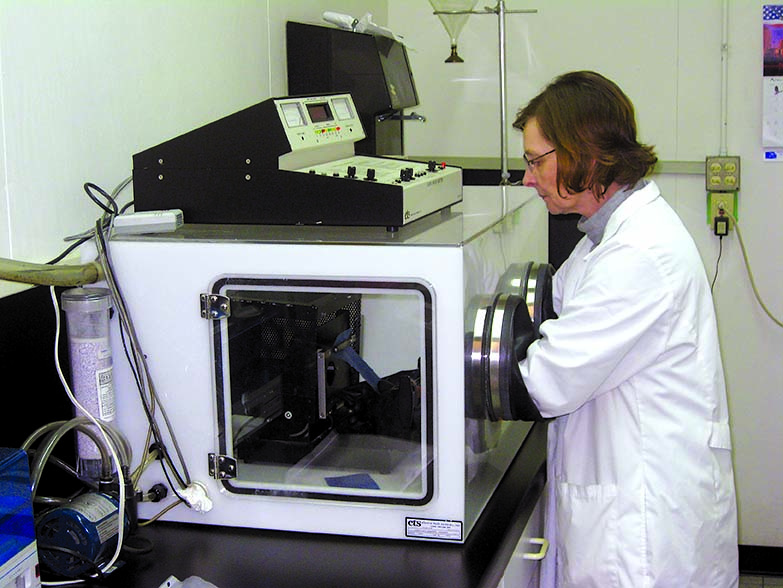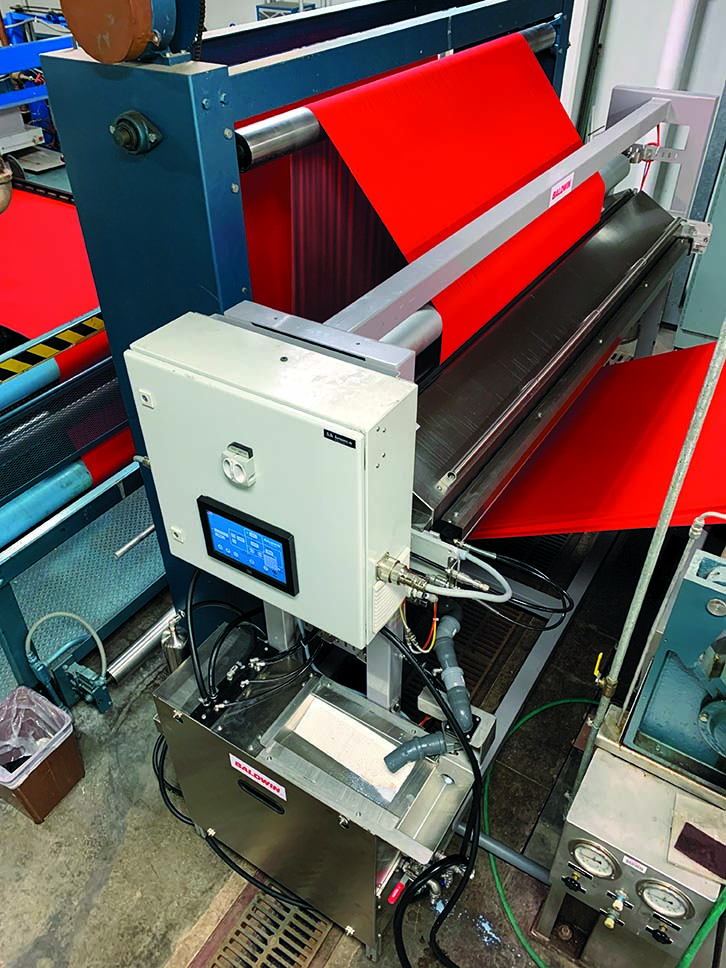
These days in the fabric finishing world, many of the biggest tasks don’t even involve the latest and greatest advancements in fabric protection. There’s just as much effort, if not more, being made to improve the methods by which that finishing is accomplished.
What are finishers focusing on right now?
“PFAS-free protection is toward the top of the top of the list,” says Brian Rosenstein, CEO and co-owner of TSG Finishing LLC
in Hickory, N.C.
PFAS—which stands for per- and polyfluoroalkyl substances—are sometimes called “forever chemicals.” “That’s because they never break down in the environment,” explains Rosenstein. “There are 9,000 different PFAS chemicals that are out there, and they’re used in everything. A very small group of them have been found to be unhealthy to both humans and the environment.”
The problem is they also provide the highest level of protection against water-based and oil-based stains, so they are very effective in providing what people want from their fabrics.
TSG Finishing has found ways to cut the use of PFAS in some of its water- and stain-repellent finishes and will continue to make more such advancements, according to Rosenstein. “In the woven residential and contract markets, everybody is asking for PFAS-free,” he says. “It’s one of our primary focuses and it’s a primary focus for our competitors.”
But there are complications. “The federal government is really dragging their feet in providing oversight and regulation on this,” says Rosenstein. “Individual states are coming up with their own laws and already beginning to produce restrictions on PFAS, but they’re doing it for the entire class of PFAS chemicals, as opposed to only those that have been proven scientifically to be bad for the environment.”

Changing performance levels
“Unfortunately,” he adds, “this effort doesn’t amount to new business. It’s not inventing a new mousetrap. It’s actually providing less protection for fabric, so consumers are going to be unhappy with the level of performance they’re getting. Regulators and legislators are leaving us with no choice, and customers are calling me and asking, ‘Do you have a PFAS-free version? I don’t want PFAS on any of my fabrics.’”
To become greener, alternate options are going to be required. “We are seeing more moisture barriers, which is not the same thing as a durable water and stain repellent [DWR],” says Rosenstein. “While a DWR gives you enough time to go run and get a paper towel to clean up the liquid, a moisture barrier prevents that liquid from ever being absorbed into the fabric, the seat cushion or apparel, or whatever it might be. Moisture barriers don’t stop the fabric from being stained—they stop what is under the fabric from getting wet.”
Rick Stanford, vice president for global business development–textiles at Baldwin Technology Co. Inc., headquartered in St. Louis, Mo., faces many of the same issues.
Chemical companies have had to get creative and go out and develop PFAS-free water repellence and try to make them perform well, says Stanford. But one way to reduce exposure to chemicals when finishing apparel fabrics is by changing the way they’re applied.
“Finishing is the process of applying a specific chemistry to the fabric to give it a desired performance,” Stanford explains. “The chemistry, for example, is applied to make the fabric softer, waterproof, flame-retardant, or prevent odors. Usually, these chemicals are applied via a pad finishing process. Simply put, the fabric is dipped in a bath and the excess is removed with squeezing rollers. The fabric is then dried in an oven commonly known as a stenter frame.”

Chemicals touch the skin
“The padding process saturates the chemicals throughout the fabric,” he explains. “For example, durable water repellents are only needed on the face of the fabric to give the desired effect. When using the padding technique, the water-repellent chemical is touching the skin, which can be detrimental to health while providing no functional benefit.”
Baldwin’s goal, says Stanford, is to revolutionize the finishing process with its precision spray technology known as TexCoat™.
“When we apply the durable water repellent using precision spray technology, only the face of the fabric contains the chemical. The functional performance standard is met without the finish touching the skin,” he says.
“Rather than with the old ‘dip-and-squeeze’ pad process, TexCoat applies the exact amount needed and only where it’s needed,” he explains. “It’s done digitally through our precision spray valves using noncontact technology. TexCoat has only 4 liters of chemistry on board at any given time, whereas pad baths have up to 150 liters.”
A process that uses less water is a big deal.
The textile industry as a whole is one of the world’s largest culprits of water pollution, particularly in the dyeing and finishing process, according to Stanford. “Textile processing requires a substantial amount of water and energy just to make a single T-shirt or pair of jeans,” he says.
Lofty goals
Major brands and retailers are setting lofty goals for themselves and therefore their supply chain to use sustainable methods and make significant reductions to their carbon footprint. And consumers are pushing for “greener” fabrics.
“What happens with the 150 liters in the pad bath at the end of the production lot? It literally goes down the drain and into the wastewater. Using less chemicals and water is obviously more environmentally friendly,” says Stanford. “There’s less water that needs to be dried in the stenter frame, and less water to be evaporated means less electricity and less gas. In the past, this has all been a very energy-intensive and mechanically driven technology. Pad finishing has gone through evolutionary changes, but precision spray finishing is revolutionary. It’s taking a mechanical process and really digitizing it.”
Daniel Banks, director of research and development at SBI Fine Fabric Finishing in Athens, Texas, spends his days working to create unique solutions for his customers’ needs and anticipating changes in the finishing industry.
For example, he says when CAL 117 (California Technical Bulletin 117, which sets the standard for upholstered furniture flammability regulations) became part of a national law, SBI had already been working on a chemical-free solution to that for several years. “Our research is usually driven by listening closely to our customers, and their ideas and challenges guide our research efforts,” says Banks.
Banks also sees the push and pull between finishing effectiveness and environmental concerns.
“It can be a huge selling point to have organic cotton, but organic cotton can be very expensive, and how do you make that last as long as possible?” he says. “Stain protection and backings can increase durability significantly. Some fabrics, by the addition of stain protection and light knit backing, can have their life span nearly doubled.”
What about advancements in areas such as flame retardancy and antimicrobials? “It’s quiet, it’s very quiet,” says Rosenstein. Instead, he says many of the projects his company is working on “are the types of things you’d see on Shark Tank.”
“Can you do it?”
“People are coming to us and saying, ‘Here’s what we want to do; can you do it?’” he says. “They might say, ‘I am doing this overseas, but I want a domestic supplier in the United States. Can you help?’ I’m getting more Shark Tank–type projects than ever before. I don’t know if that’s because there are more entrepreneurs out there or Kickstarter campaigns. But it has nothing to do with PFAS.”
In the end, fabric finishing in many ways comes down to trade-offs. “If you’re trying to use a highly renewable resource to make fibers, it can be difficult to make it durable for commercial applications,” says Banks. “But it does seem that designers are wanting those products as natural and as green as possible. What’s driving their choices is what is beautiful and what is sustainable. The question for us is how do we increase the usefulness and durability of these fabrics while retaining the same look and feel?”
Jeff Moravec is a freelance writer based in Brooklyn Park, Minn.
 TEXTILES.ORG
TEXTILES.ORG


